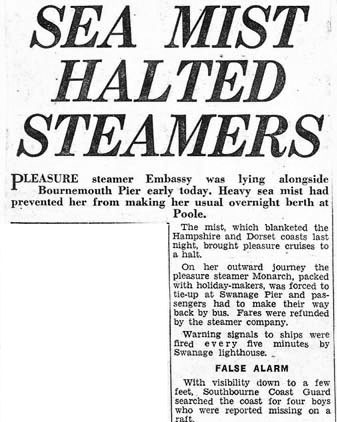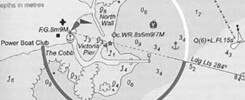
The picture above gives a good impression of the disorienting effect of looking out into fog and not seeing what you expect to see!
Just before Christmas a certain level of chaos broke out at London’s Heathrow Airport as fog enveloped much of the south of England. In the high tech wonderland which we inhabit in the developed western world today, such a simple thing as the weather getting in our way comes as a bit of shock to many. But it is not so long ago that weather, and particularly fog, could stop everything.
In the days before radar and satellite navigation, fog was one of the mariners’ greatest nightmares. A captain might have felt comfortable out at sea with plenty of room around him and ample water underneath his keel but, as land got closer, the palpitations of his heartbeat on the bridge would inevitably have stepped up a gear. For excursion paddle steamer captains fog was particularly bad news as most of their work was in confined coastal waters beset with potential hazards and often with complicated approaches to piers and harbours, each with their own wind and tidal vagaries. These could be hard enough to judge when the captain could see where he was going and harder still in the disorienting cloak of a thick fog.
Of course the paddlers had compasses to steer by and towed logs astern to get the distance run if necessary so a dead reckoning position could be obtained and this could be backed up by taking soundings of the depth of water with the lead line. Then there were the sound signals, not only of other ships, but also on some buoys, headlands and lightships. For the excursion steamers, there were also the bells or claxons on most of the piers and harbour entrances. So in fairly thick weather a paddle steamer captain could usually navigate successfully up to to a point and if he heard the sound of the pier bell or claxon, home in on it. But life is sometimes not so simple and, if he were in any doubt, any competent captain would have gone to anchor and waited until the visibility improved. Inevitably this sometimes led to passengers who had expected being home in time for tea having their travel plans amended, sometimes quite a lot, as the following three press cuttings, taken at random from 1937, 1958 and 1961, show.

One hundred and and twenty five excursionists in the red funnel steamer Balmoral spent the night at sea owing to the fog which covered a large area late last evening. The Balmoral left Southampton for Bournemouth and Cherbourg yesterday morning. She was due back at Southampton at 10pm but on the way from Bournemouth she ran into thick fog near the Needles at 10pm and had to remain anchored until 5am this morning when she groped her way up Southampton Water to the Royal Pier, arriving at 7.45am. One of the passengers told the Echo “Everybody kept cheerful and made the best of the situation. There were all night card parties and music was relayed most of the time. Lifebelts were used as mattresses on deck and some managed to snatch a few hours’ sleep, but this was not easy when all around us other ships at anchor were sounding their fog horns.

The Balmoral’s trip to Cherbourg this morning was cancelled. Fog also delayed the Southern Railway cross Channel boats. The Hantonia from Le Havre, the St Briac from St Malo and the Minster from Guernsey were all several hours late arriving at Southampton between 10 and 11 o’clock today. The Haslemere, also from Guernsey, making her way through fog almost all night managed to reach Southampton at 8am.” The North German Lloyd liner Europa, from Bremen to New York was delayed and instead of going to Southampton Dock, she embarked passengers by tender off the Isle of Wight.
4th August 1937


Pleasure steamer Embassy (above) was lying alongside Bournemouth Pier early today. Heavy sea mist had prevented her from making her usual overnight berth at Poole. The mist which blanketed the Hampshire and Dorset coasts last night, brought pleasure cruises to a halt.

On her outward journey, the pleasure steamer Monarch (above), packed with holiday makers, was forced to tie up at Swanage Pier and passengers had to make their way back by bus. Fares were refunded by the steamer Company. Warning signals to ships were fired every five minutes by Swanage Lighthouse. [This is interesting as I don’t think Swanage had a lighthouse. I guess they meant Anvil Point Lighthouse just round the corner? JM] With visibility down to a few feet, Southbourne Coast Guard searched the coast for four boys who were reported missing on a raft.
7th July 1958

Ninety passengers – including many children – went ashore at Swanage today after spending an unexpected night at sea – fogbound in the 250 ton paddle steamer Swanage Queen, which left Bournemouth yesterday evening. Mr H Jennings, Managing Director of the Brighton and South Coast Steamers Ltd, owners of the vessel, said the Swanage Queen was unable to locate Swanage Pier in the fog and her master decided to drop the anchor in deep water and wait for the weather to clear. The vessel which had been 25 hours at sea, left Swanage on Friday morning for a trip to the Isle of Wight. Returning she left Bournemouth about 6pm for the run to Swanage, but the fog came down like a blanket. Radio contact was maintained through Niton radio while at Swanage Pier Piermaster Mr Harry Marsh and Mr Jennings answered anxious inquiries by saying that all was well with the vessel but she was fogbound. Meanwhile on board, passengers made the best of the situation, aided by the crew. Most of them obtained some sleep and food and drink was made available in limited quantities. Mr Marsh said the fog was the worst he had experienced. “I was up all night and at times visibility was down to 10yds” he added. Relatives of some of the passengers were on the pier when the steamer berthed this morning. Others jammed the pier switchboard with calls during the night. [I suspect that the grandly styled pier switchboard comprised just a single telephone line in 1961, probably manned by Mr Marsh himself! JM] Dense fog again delayed shipping in the Straits of Dover today. Several Channel swim attempts which were to have started early today, had to be put off.
1st September 1961
Even for some while after radar began to become commonplace in the 1960s, ships would generally go to anchor in thick fog rather than try to get into harbours. If the captain or pilot got it wrong the potential consequences were just too devastating. In the summer of 1968 I was on the Channel Island mailboat Sarnia. Her master, Capt Harry Walker, who became the Marine Superintendent several years later, was a cautious man and, in a weekend of much fog, we were running very late after spending a considerable amount of time at anchor. There was some muttering amongst the passengers about too much caution delaying people’s holidays, particularly when we learnt that her sister ship, the Caesarea, was running bang on time under the command of a captain with a great reputation as an excellent seaman and for not letting any little difficulties stand in his way. As a callow youth I was a little envious that we were not on the punctual Caesarea instead of aboard the Sarnia swinging at anchor in the fog off St Peter Port.
Then came the news. The Caesarea had been involved in a near miss with a frigate off Portland Harbour and had damaged her hull on the Mixen Rocks off the entrance to Weymouth by coming in too close to the end of the Stone Pier in the fog before swinging to back into the harbour. She was withdrawn from service, temporarily patched up and sent to drydock for full survey and repairs with the St Patrick coming down from Dover to stand in for her. That particular master left the company shortly afterwards. It was a useful lesson in life for a brash youth.
Kingswear Castle returned to service in 2023 after the first part of a major rebuild which is designed to set her up for the next 25 years running on the River Dart. The Paddle Steamer Kingswear Castle Trust is now fund raising for the second phase of the rebuild. You can read more about the rebuilds and how you can help if you can here.
John Megoran


